Performance report
Updated 25 September 2019
Applies to England and Wales
Overview
The purpose of the overview is to give a summary of HM Land Registry, its purpose and performance against objectives.
HM Land Registry at a glance
Our ambition
HM Land Registry is committed to becoming the world’s leading land registry for speed, simplicity and an open approach to data, and aiming to achieve comprehensive registration by 2030.
Our mission
Your land and property rights: guaranteed and protected.
Our primary role
Land is our nation’s greatest asset. Clarity and security of land ownership is essential to a functioning property market. A healthy market is essential to a successful economy and society. Land is used to support all dimensions of life – agricultural, business, social and personal. Its financial value may fluctuate, but its vital role in life remains the same.
We provide that necessary clarity and security in property ownership and interests. We do this by maintaining a Land Register of more than 25 million land and property titles in England and Wales valued at £7 trillion, enabling more than £1 trillion worth of personal and commercial lending to be secured against property. The records are state guaranteed. We enable property transactions to be registered accurately, efficiently and safely. This provides trust and confidence in the property market and thereby in the economy generally.
Our values
- We give assurance
- We have integrity
- We drive innovation
- We are professional
Our statutory duties
HM Land Registry was established in 1862. We are a non-ministerial government department, an executive agency (since 1990) and a trading fund (since 1993) that makes no call on funds voted by Parliament.
The Land Registration Act 2002 empowers us to deal with “the business of registration” and is our primary governing statute. Our income from fees covers all of our costs under normal operating conditions.
The head of HM Land Registry is the Chief Land Registrar, appointed under statute by the Secretary of State for Business, Energy and Industrial Strategy (BEIS) who has Parliamentary responsibility for HM Land Registry and for the legislation under which we operate.
The Infrastructure Act 2015 enabled HM Land Registry to start to compile a national register of local land charges.
Our services
Our ambition to become the world’s leading land registry for speed, simplicity and an open approach to data was announced by the Government in February 2017. This was followed by the publication of HM Land Registry’s Business Strategy for 2017- 2022 in November 2017.
For more than 150 years it has been our privilege at HM Land Registry to provide an extraordinary breadth of services whose simple purpose is to maintain clarity and security in property ownership and secured lending and to support swift transactions. We have provided the trust and confidence the market and economy need through being expert and having integrity in all we do.
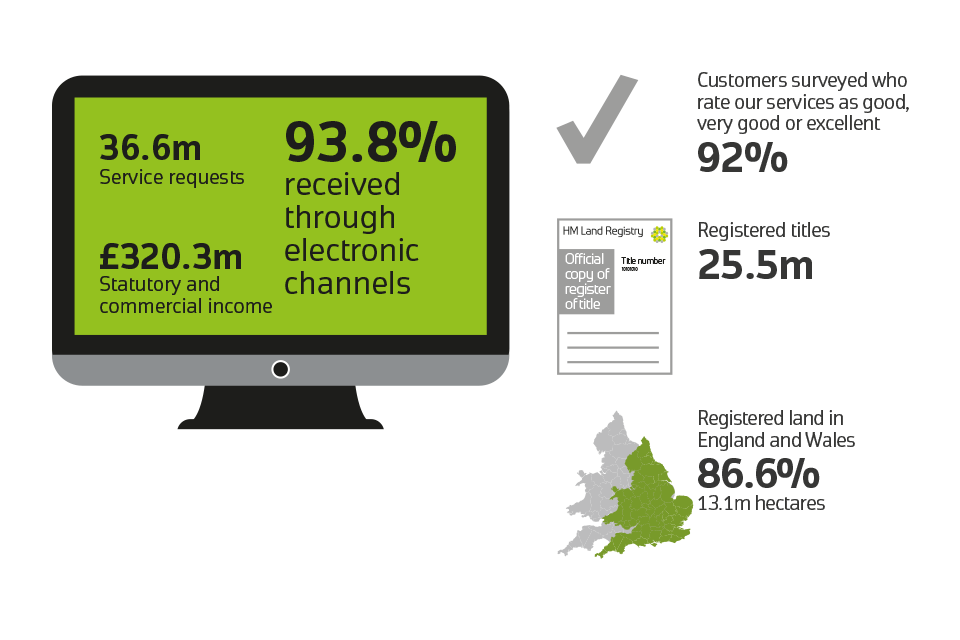

Our role in the property and financial markets
What our customers ask
Looking for a property:
- what’s available close to home?
- how big is the garden?
- how big is the car park
Arranging a mortgage:
- how much can I borrow?
- what’s the property worth?
Before the exchange:
- is the land registered?
- who owns the property?
- is there an outstanding mortgage?
Exchange of contract
- is the offer protected?
- has the seller’s conveyancer searched the register?
Completion
- has my loan been registered?
- has the sale of the property been completed?
Living and working in the property
- are my details up to date?
- how can I stop myself being a victim of property fraud?
- I need to remortgage
Examples of our services that can help at every stage
Looking for a property:
- register view
- price paid data
Arranging a mortgage:
- land charges search
- house price index
- bankruptcy search
Before the exchange:
- search of the index map (search of the national map)
- official copy (official copy of a register entry)
Exchange of contract
- register updates
- registering new titles
Completion
- official search (completion priority protection)
Living and working in the property
- Property Alert (free property monitoring service)
- digital mortgage
Our services
Information services
Income £19.5 million Application volume: 7.8 million
We hold one of the largest transactional geospatial property databases in Europe and since 1990 our register has been open to the public. Our online services let people check whether a property is registered (without the specific details), check the progress of their request and receive notifications to protect their property against fraud for free. For a small fee anyone can get an instant snapshot of the details for any registered property.
Views of the register £19.5 million Application volume: 6.6 million
MapSearch Free Application volume: 1.2 million
Register change services
Income £230.5 million Application volume: 7.2 million
When things change, the register needs to be updated accurately. Properties are sold, homes and office buildings are remortgaged, owners get married or property is transferred when owners pass away. When buildings are split into flats, portions of land are sold on and new developments completed, new titles need to be created. Changing the register can be complex so this is where our expert caseworkers focus their technical knowledge and experience.
Register updates £148.6 million Application volume: 6.7 million
New leases £26.7 million Application volume: 200,000
Transfers of part
£38.8 million
Application volume: 200,000
First registrations £16.4 million Application volume: 100,000
Guaranteed queries
Income £58.9 million Application volume: 20.1 million
Our search of the index map, official copies and official searches services provide protection and assurance to property professionals and citizens by protecting transactions while the transfer is completed. These services are largely automated so customers can get their results instantly, making conveyancing faster.
Official copies £50 million Application volume: 16.7 million
Searches of the index map £1.1 million Application volume: 800,000
Official searches £7.8 million Application volume: 2.6 million
Other services
Income £11.5 million
Our Local Land Charges service, launched in July 2018, can reveal whether a property has restrictions on its use. Our digital Land Charges service protects certain interests in unregistered land and we maintain the bankruptcy index for England and Wales. Our Agricultural Credits Department is responsible for maintaining a register of short-term loans secured on farming stock and other agricultural assets.
Land Charges and Agricultural Credits £7 million
The information in our register is valuable to a wide range of users from property professionals and financial institutions through to tech start-ups and infrastructure specialists. Our data, available directly from us or via tech intermediaries, enables property technology (PropTech) entrepreneurs to create new products, allows buyers and lenders to make more informed decisions and facilitates transparency to combat fraud and corruption.
Commercial services £4.5 million
Statutory and commercial income
£320.3 million Service requests: 36.6 million
The total income figure includes refunds. The income figure for each individual service in this diagram excludes refunds.
The service requests figure includes 1.6m telephone calls and items of correspondence.
Chair’s statement
By Michael Mire

Her Majesty’s Land Registry has an illustrious reputation. For 157 years we have imparted our expertise and objectivity to secure England and Wales’ immense property wealth.
Two years ago, we launched an ambitious Business Strategy that set out to reveal another side of this prestigious institution – our ability to take a leading role in a digital transformation of the property market.
In the second year of the strategy that leading role has been firmly established.
The Digital Street community we lead has grown as more industry players from banks and building societies through to property lawyers and PropTech innovators have joined us to help show the world how blockchain and smart contracts could deliver seamless transactions in the future. Internally we have reshaped our underpinning technology architecture and trialled a new intuitive casework system and we are now using robotic processing to remove simple tasks from our registration experts.
Our data continues to fuel the growing digital economy through the release of new datasets and our Geovation programme which supports PropTech entrepreneurs to create innovative products and services with our data. So far, our £160,000 of seedcorn investment has resulted in more than £6m worth of third-party investment.
We hold some of the most valuable location intelligence in the world. We are taking a leading role with the Geospatial Commission in linking it with multiple data sources to unlock the huge amount of economic value in geospatial data.
Our colleagues remain vital to our future plans. At each meeting the Board directors hold breakfast sessions with colleagues to talk about the future and the challenges we face in creating a world-leading land registry. Those sessions have been invaluable to me. They have enabled a dialogue about how we ensure we empower and develop our experts and help to recruit and retain the most talented people. Without them, we will not be the world’s best.
While we look to the future, we have not lost our focus on the vital role we play day-in-day-out in the smooth running of the residential and commercial property markets and the underpinning of property lending.
Even with one of the highest demand years we have seen in recent times, we still retained good customer satisfaction and achieved our quality targets. However, while we have met the standard for first registration of unregistered land and large housing developments we are not yet meeting the standard for other complex new title work. Tackling this will be our top priority for next year.
While our aims may be ambitious, our plans are realistic, delivering the changes our colleagues and our customers need and want today while preparing for a future that may be radically different.
I am both honoured and excited to chair HM Land Registry as our transformation ambitions become a reality. You can read about the programmes of work that will achieve our aims in this Annual Report.
Interview with Mike Harlow, Acting Chief Executive and Chief Land Registrar

What has struck you about the organisation since you joined HM Land Registry?
It is a huge privilege and responsibility to be part of the leadership of the organisation at this important time. I have worked in the property industry all my career. For 14 years I was a lawyer in private practice using HM Land Registry’s services. I know the trust and confidence that HM Land Registry provides the market through its clear, secure and accurate records. I know that comes from the care and expertise of our experienced colleagues. I know how reliant the country is on the proper functioning of land registration.
What surprised me when I joined HM Land Registry was the true scale of its role. We have this year estimated that the 25.5 million titles in the register covering 86.6% of England and Wales are worth £7 trillion and that more than £1 trillion of debt is secured on them.
Why is the transformation programme so important?
The country’s greatest single asset is its land and yet the property market is significantly slower, less well-informed and less efficient than others, such as the share market. New technologies, such as artificial intelligence, machine learning and blockchain, present a great opportunity to allow businesses and people to make faster and better buying decisions and to transact and borrow against land with more confidence, greater ease and lower overall cost.
Land in England and Wales is our primary resource for life. It provides our homes, our food, a place for our businesses, space for recreation, natural beauty, heritage and our infrastructure. The way we enable land to be owned and sold fundamentally affects our social wellbeing, our environment and our prosperity.
Land registration gives people control and flexibility in their ownership of land. It supports housing, mobility, business development and inward investment.
The importance of making the most of this vast and permanent asset right now cannot be overstated.
HM Land Registry has an ambitious strategy to capitalise on the revolution in digital technologies and become the world’s leading land registry for speed, simplicity and an open approach to data.
We want to be world leading to enable the property market in England and Wales to be the best it can be. We want to use the latest technology to help the market to be better informed, simpler, faster and cheaper. All the while, we know we must maintain trust and confidence by being brilliant at the basics. This means always continuing to create and maintain a clear and secure record of who owns what.
Are there risks to taking on such an ambitious strategy?
Our primary role of providing accurate and secure records and enabling safe transactions must not be put in peril. We are investing in our risk and assurance framework to bring it in line with best practice. This will ensure we can deliver our transformation confidently and at pace.
We are mindful of the possibility of income volatility in the coming year. We have reviewed our response to the fall in property transactions after the financial crisis in 2007/8 and examined key expert forecasts. We have robust mitigation plans in place aimed at maintaining momentum in our transformation and safe continuity of service.
What are the key areas of focus for an organisation that is undergoing such a significant transformation?
HM Land Registry must hold fast to its core purpose and values that underpin market confidence, while rethinking how services can be provided, starting with digital data and new technologies in mind.
We cannot do this alone, though. Land registration is but a crucial cog in an intricate machine. The way we change what we do must mesh with the other moving parts in the property market. That is why we have focused this annual report on our collaborative approach to transformation.
There are many parties involved in property transactions. They include owners, developers, lenders, agents, lawyers, surveyors, insurers, removers and so on. It is currently a complex process and there are many representative and regulatory bodies in the sector. HM Land Registry is determined to play its role in showing leadership in the industry to drive and catalyse innovation to make conveyancing simpler, faster and cheaper for all.
Strategy progress
This year was the second of our transformative five-year strategy, which has six core objectives.
Brilliant at the basics
We are moving to a single national and digital way of doing business. This year we have defined what our new operation looks like. We know the resources it needs and the functional teams it will comprise. We understand the expertise we will need to maintain the integrity of the Land Register. With all the planning complete we are now building the operations function of tomorrow.
Throughout the changes this year we have met all our speed of service targets apart from one. We exceeded our register quality target and met our increased target for customer service. We missed the target for those cases involving new title creation, which was disappointing. These cases represent 7.2% of our workload. We recognise the resource shortages in this area and are executing a plan in the coming year to address it.
We have also been working hard behind the scenes to transform our digital services, which customers will start to see in 2019/20.
World leading through Digital Street
Our Digital Street research and development programme has engaged more than 250 businesses and institutions. Our partners in this virtual community are helping us understand the potential of the property market. They have been steering our work and collaborating on how distributed ledger technology (blockchain) could speed up and secure the property-buying process.
We are also bringing the latest technology to our own processes. We have prototyped new digital services for our colleagues, which included introducing Robotic Process Automation for the first time. We have laid the foundations for a digital future by upgrading our IT infrastructure, developing our digital expertise and preparing to use machine learning to create a truly digital register.
A comprehensive register
Our aim is to complete registration of all residential and commercial land by 2030. Once the register is practically complete, the market will no longer have to deal with the complications of unregistered land. The register data will also be more useful, as service providers will not have to cater for gaps in coverage.
This year we helped to create and publish a list of all unregistered public sector land, meeting our first key milestone. This list will help us work with public sector bodies to identify and register unregistered land. The priority will be those areas with the greatest housing need.
Opening our data
Unlocking the full potential of land in the economy is partly dependent on making land data digital, useable and open. Our data is a cornerstone of a better-informed property market.
HM Land Registry is one of six national geospatial data organisations, collaborating with the Geospatial Commission to establish standards and methods to combine geolocated data. This will improve its usefulness in the property market. It will also provide an important resource for commercial and public services.
Our Geovation programme we run with Ordnance Survey continues to help us understand the true potential of the data we hold. Since October 2017, we have invested £160,000 of grant funding in 14 PropTech companies who have raised more than £6 million of third-party investment.
Expert people
We are experts in land registration law and process. Our future success rests on the commitment, integrity and expertise of our colleagues. We want every colleague to feel valued and respected for who they are and how they can contribute to our hugely responsible and ambitious task. We want a diverse workforce with an inclusive culture that has a strong sense of shared values.
This year we exceeded both of our colleague engagement targets with scores now at a record high. Our ongoing work to empower, develop and support our people was recognised with three industry awards this year.
Our new strategic workforce planning model, new recruitment and selection process supported by career and training paths across all key professions are enabling us to attract and nurture some of the best talent across the private and public sector.
Financially strong
All our investment in transformation continues to come from our fee income alone. The Local Land Charges Programme is funded from reserves established from fee income surpluses in previous years. This year we invested £31.8 million in transformation (up from £13.8 million 2017/18) and £4.3 million in building the Local Land Charges Register.
We ended the year with a small retained surplus of £5 million.
Our fee structure can be confusing for customers, making it difficult to understand and operate. This year we have laid the ground for a new fee structure to be introduced from April 2020 onwards. The new fees will simplify services and improve our resilience.
Interview with Lisa Barrett, Chief Executive, Land Information New Zealand (LINZ)

New Zealand is top of the rankings for ease of doing business in property. How has Land Information New Zealand contributed to that?
A significant contributor to the nation’s success has been our digital approach to conveyancing. Our register of two million titles has been truly digital since the early 2000s. Entries to the register can be completed electronically. ‘Landonline’ is our digital platform on which all the parties to a transaction log their intention to deal with a property.
The lawyers representing the parties individually certify the information provided. On this basis, and following strict business rules agreed by the Registrar, the register can then be automatically updated at the same time as the transaction completes in 87% of cases. A team then audits the register changes to ensure that the rules have been followed and therefore the register retains its accuracy.
Introducing this digital approach reduced costs considerably and increased fraud resilience. Fraud is always a concern to land registries. It continues to be negligible. The speed and convenience is now an accepted part of the overall conveyancing process and a significant contributor to the ease of doing business in property.
What challenges did you face and how did you overcome them?
In the 2000s, Landonline was initially voluntary for lawyers. As a sector, they were going through their own digital transformation. LINZ spent considerable time and money on training and educating lawyers, and their staff, in using the system and understanding its benefits to them. As an organisation we also underwent considerable process change, which was a big transformation for staff. The shift was a success due to the partnership with the Law Society, clear communication and a determination to see the changes successfully implemented.
What are your future plans to support the New Zealand property market?
We are putting land data to best use in the economy. We have a cadastral system – where the base map for titles is measured by reference to fixed points on the ground. That layer of data and all the others that LINZ holds are openly available.
We are also working up plans to introduce a network of geospatial data providers, including local authorities. We hope this federated model for combining data will support commercial and public services.
We also need to update Landonline so that it stays world-class and can work with modern-day conveyancing casework systems using APIs (application processing interfaces).
Director reports
Brilliant at the basics
Chris Pope, Chief Operations Officer

The year 2018/19 was one of HM Land Registry’s busiest, despite reports of a slowing property market, with over 4m more service requests than in the previous year, making it one of the highest demand periods in the last five years.
We have met that challenge head on by continuing to deliver a great service to more than 13,000 professional customers throughout England and Wales, ensuring the market can operate and thrive. We have met our targets for quality and invested time to help conveyancers improve the quality of information they submit to us.
We have also invested in the transformation of our operations, creating the foundations on which to build a national digital function, as we prepare to restructure our teams under a new operating model.
Finally, we continued to make good progress against our ambition to have a comprehensive register by 2030 – finishing the job of ridding the system of unregistered land that started more than 150 years ago.
Delivering a great service to the nation
In 2018/19 we processed more than 36.6 million service requests, through either our automated channels or by one of our more than 3,000 registration experts. We are delighted to have once again met our ambitious customer key performance indicator, with 92% of customers surveyed rating our performance as good, very good or excellent.
We provided a rapid turnaround of searches of the register, updates to existing entries and other more straightforward services which are vital to the everyday smooth running of the market. Registrations of previously unregistered land and registrations of medium and large new-build developments were also completed within our service standard.
While turnaround times for the complex business of other new title creation were below service standard, we made significant improvements to our service. For customers who manage complex commercial and infrastructure developments, we have now introduced new tailored services to help them register their interests and inform site acquisition decisions. This will enable the nation’s most economically important projects to deliver at pace.
Guaranteeing high quality
We take great pride that for the fifth year in a row we have met our stretching quality targets. We have developed a more stringent measure of quality for the coming year.
Successful land registration relies on both the checks made by our staff, and the certifications given by regulated legal professionals. Every day our registration experts issue more than 3,000 requests for information (requisitions) due to omissions or inaccurate information in applications to change the register. Some are as simple as spelling a name wrong or incorrect fees. Some are entirely justified. Some we could avoid. Others could be avoided by the legal profession. These cost us and our customers unnecessary time and money and they could affect the quality and security of the register.
Collaborating with customers
This year we are poised to introduce smart forms to our online business portal to prevent incorrect entries or missing information and we hosted more than 12,000 customers via our educational webinars. In March we published the data we hold on the number of applications by firms that need further information. These initiatives have contributed to a fall in the rate of requests for information from 19.4% at the end of 2017/18 to 18.9% at the end of 2018/19. The rate per working day has fallen from more than 5,000 at the start of the strategy to just under 3,600. This has resulted in an estimated £214,000 worth of savings for ourselves and will also have resulted in savings for our customers. Reducing these errors and omissions from customers is a trend we will continue to invest in next year.
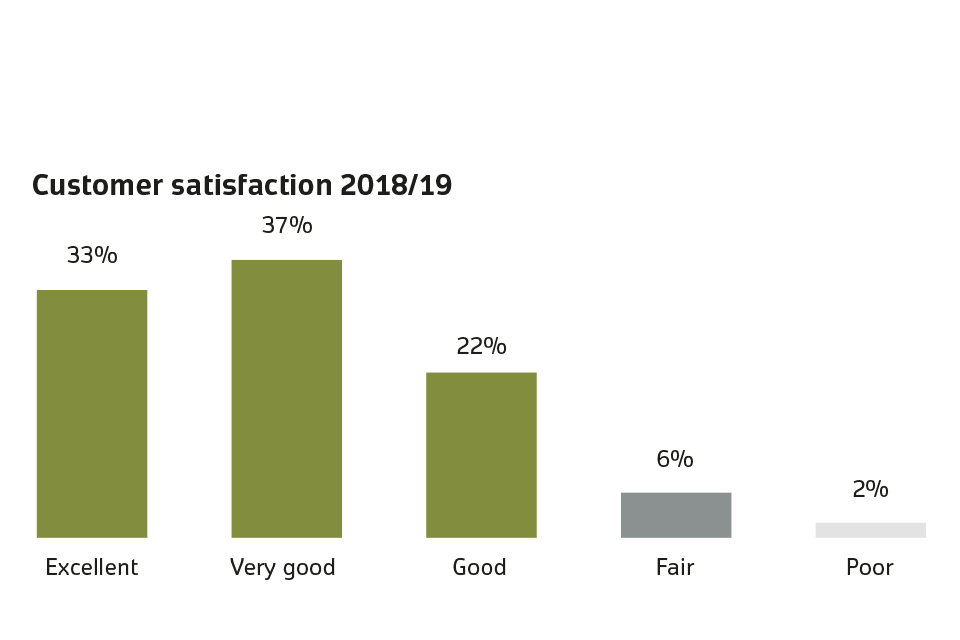
Mills & Reeve
Law firm Mills & Reeve LLP joined our pilot Application Management Service in June 2018. The new service aims to make it easier to register complex commercial, retail or infrastructure transactions. We give customers a point of contact and direct access to registration experts. Our experts help identify and address potential issues before they submit their applications. They then manage their registrations throughout the lifecycle.
Experienced caseworker Ben Smith provided Mills & Reeve with dedicated support. He advised on the quality and scale of their transfer plans, leading to successful registration completion.
A Mills & Reeve spokesperson said:
You managed to achieve, in less than one month, what we’ve been trying to get done for over four years. Having one person to work with throughout who understood what we were doing was invaluable.
Transforming operations
Angie Clarkson, Deputy Director Registration Services

We need to be brilliant at the basics. For more than a century HM Land Registry has based its operations on paper, the post and districts. Today our processes are in part still running with this legacy. Our aim is to move to a single national and digital way of doing business. Over the last 18 months we have grown our operations function by 17.5%, welcoming more than 1,000 new colleagues into our organisation to develop the technical experts of the future.
To become brilliant by design we are introducing a new operational model for a digital future, enabling us to be an expert and resilient organisation that can cope with fluctuations in demand while still delivering a consistently high-quality service to our customers.
Those changes will take time to complete and mature. By 2021 all our registration colleagues will be operating in the new model, meeting our speed of service and quality targets with confidence.
UK bank ring fencing: Updating 4 million title entries
In response to the financial crisis, a number of domestic and international reforms to bank regulation were introduced that required lenders to separate their domestic and commercial borrowing portfolios. These vesting orders came into force between 1 April and 13 August 2018.
As a result, millions of our titles containing charges (such as mortgages) required updating with the additional complication that ring fencing requirements meant that lenders with multiple charges on a title might transfer to multiple entities. We estimated that this would have taken over 3,500 case working days to complete manually by our registration experts.
Registration colleagues in Birkenhead worked with our digital experts to create an automated process that would minimise the need for caseworkers to manually process the changes. The new system created a unique ID to address the issue of multiple charges on the same title, thus enabling the automatic completion of changes to individual charges.
More than 2.6 million updates were successfully made over a six-month period and were completed at a rate of approximately 100,000 per week, with less than 1% requiring caseworker intervention.
Achieving comprehensive registration
Maggie Telfer, Deputy Director Register Completion

Land can serve multiple purposes, for many people, but the owner may not always be clear. That is why, since the first title was created in 1863, there has been an ambition to register the entire land mass of England and Wales.
Today, more than 25.5 million property titles are registered, and in 2018 we reached 86.6% registration of England and Wales. In 2018/19 we completed 108,074 first registrations, which equates to 180,354 hectares of land with a value estimated at more than £19 billion. Comprehensive registration is a vital component of meeting the demands of one of the most highly sought-after property markets in the world. Our aim is to complete the registration of all residential and commercial land by 2030 with a focus on public sector land by 2025.
This year, for the first time, a list of all the unregistered public sector land in England and Wales was published by the Ministry of Housing, Communities and Local Government.
Our expert teams are now working closely with local authorities and public bodies across England and Wales to identify any unregistered property assets and to register them in the most streamlined and cost-effective way.
Network Rail
In November 2017 Network Rail announced the sale of their commercial estate in England and Wales made up of around 5,200 properties with an estimated value of £1.46 billion. The majority of the properties are converted railway arches.
We were involved in detailed discussions about the registration requirements to support the sale of their commercial estate which we are now in the process of registering. This has led to further discussions about how to take forward the registration of the whole of Network Rail’s infrastructure and estate. We knew that this would be a challenging and complex undertaking, so have been investigating what areas to pilot to inform what our joint approach should be.
Nurturing our most valued assets
Jon Cocking Acting Director of Human Resources, Organisation Development and Corporate Communications

We are expert in all aspects of property and land registration law and process. The medieval roots of our system, combined with the limitless variety of ways people put land rights together, makes for a highly complex system. We have to remain experts in all those dimensions.
That is why people remain at the heart of our plans to transform HM Land Registry. We are now in the second year of delivering our People Strategy which focuses on building a world class organisation by developing and recruiting talented people, empowering our experts and developing a winning culture through better leadership and communication, and also creating an inclusive environment by supporting and nurturing communities both inside and outside the organisation.
Working with colleagues, their representatives and a range of external partners, our people are beginning to see and feel a real difference in the shape, culture and purpose of the organisation.
Building a world-leading land registry
Our ambitions rely on having talented people with the right skills at the right time. Our new strategic workforce planning tool allows us to match resource needs to the work profile to make more accurate resourcing decisions and develop better tactical recruitment plans.
This year we replaced our recruitment and selection processes with a more open, fairer and inclusive approach which places emphasis on the candidate fit with the role, based on a holistic view of their experience, skills, behaviours and strengths. With career and training paths across all key professions, running from entry level through to senior management, we are attracting and nurturing some of the best talent across the public and private sectors.
Our industry-leading apprenticeship programmes won wide appreciation. The scale and ambition of our main apprenticeship programme were recognised by Personnel Today’s Excellence in Public Service Award and the Learning & Performance Institute’s Apprenticeship Programme of the Year. Since September 2014, 553 apprentices have joined HM Land Registry, with a 92% completion rate and 76% retention rate.
Our future development approaches will focus on digital, complex registration, change and project management skills alongside specialist financial and commercial awareness. We will continue to develop world-leading programmes and approaches to support them.
Empowering our expert people
We are committed to exemplifying a diverse workforce and an inclusive culture where colleagues feel valued for who they are and what they do. Everyone should feel connected to the aspirations of the organisation, its values and each other.
We aimed for our engagement index score to be in the top half of organisations of similar size and nature. We finished in the top quartile.
We also aimed for our Leadership and Managing change scores to be 10% higher than our 2016 scores. We finished 12% higher with scores for ‘clear vision’ benchmarked as one of the highest performing across the whole Civil Service.
Our gains were achieved through a range of people initiatives, such as a comprehensive programme of leadership and management training which included a series of masterclasses for our senior leaders focusing on key leadership expectations. We also ran workshops across England and Wales involving more than 600 colleagues from every part of the business, who collectively helped develop what our future culture would look and feel like, and what behaviours would be needed to enable change.
A critical component has been employee communication. Our innovative and inclusive approach to internal communication gained us national recognition. We were honoured to be finalists for the Employee Engagement Awards 2018 and winners at the UK Employee Experience Awards 2019. In 2019/20 we are excited to launch our future culture initiatives as part of our ongoing journey to be one of the best employers in government.
Caring for our communities
Contributing to charitable causes that benefit local communities has always been part of our history and will continue to be part of our part of the moral and social fabric of our future culture too.
Our colleagues have taken part in a range of activities and events and in the last year raised more than £77,000 in support of local and national charitable causes and over £17,000 worth of non-cash donations such as blankets, food and toys.
Our commitment to work alongside other charitable committees has meant continued and sustained support for national initiatives such as International Women’s Day and Mental Health Awareness, as well as causes such as bereavement, animal welfare, cancer awareness, homelessness and lifesaving.
We also focus on creating a sense of community for our people too. Bringing colleagues together outside of work has always been an important part of life in HM Land Registry. As chair of our LR Leisure Committee I am proud of the passion and enthusiasm of volunteers who coordinate activities at both a national and local level through the year. Thanks to their hard work and commitment, we offer a diverse range of activities open to all colleagues to relax socially together or compete in sporting and other events – all contributing to their overall health and wellbeing.
For me the highlight of the year is always our LR Leisure Awards. Our annual gala event celebrates colleagues who have gone above and beyond to make a real difference to their work and local community alongside colleagues who have given 40 years of loyal service to HM Land Registry.

Applause for a successful colleague at the annual LR Leisure Awards, held this year in York. Photo: HM Land Registry/Jon Olliffe
Digital communities of practice
We have established a community of practice for each of the professions within Digital, Data and Technology. There are 15 in total with examples including software engineering, data science and product management. Each community takes responsibility for growing the capability of their practice to help make sure our people are equipped with the right skills and experience to succeed and are supported to develop their careers. Alongside this we have grown the Digital, Data and Technology directorate by 10% and formed strong relationships with private sector delivery partners. This has brought vital new skills and experience into the organisation.
Joe Honywill, Senior Designer said:
I might be the only designer on a team but members of the community of practice are always nearby. If I need a sounding board, someone from the community will be available. If I need a second opinion, someone from the community will be happy to give me one. If a problem has me stumped, someone from the community will help me approach things from a different angle. The community of practice is my work family.
Angharad Lewis, Head of Practice said:
Having a community of practice has meant that it’s been much easier to get people to work together on building capabilities for the whole community – we’re making change happen collectively, instead of having change happen to us. For instance, we’ve set up working groups which drive the community’s activities on things like revamping consent forms and the storing and sharing of research. Most valuably, we’re working with user research colleagues who sometimes we hadn’t even met a few months ago, who have great knowledge, experience and insights to share. Without a formalised community, it probably wouldn’t have happened.

Digital, data and technology experts problem solving at a session in our Plymouth Office
Supporting health and wellbeing

Our colleagues’ voices have been heard loud and clear through the 17,000 comments left underneath 600 blogs and articles published on our intranet. They have enabled reaction, clarification and idea sharing. A healthy dialogue has flourished with the Chief Executive and other senior leaders.
Over the last year, we have published blogs to raise awareness of mental health issues and support a diverse and inclusive workplace culture.
We communicate personal stories to encourage colleagues to find confidence in themselves and their abilities, regardless of ethnicity, religion, sexuality, gender, disability, age or mental health status.
Liam Cawley wrote honestly and openly about his experiences with dyslexia and dyspraxia as part of an ongoing health and wellbeing campaign. The response to the article was overwhelmingly positive and has encouraged others to come forward and talk about their own experiences with neurodivergence and mental health issues.
The author received commendation and support from colleagues across the organisation. Angie Bird of Peterborough Office commented:
The more we are aware [of dyspraxia], the more we can do to help, to not judge and to appreciate the skills that every individual brings to work with them.
Safeguarding the property market
Robin Malpas, Acting Deputy Chief Land Registrar, and Mike Westcott-Rudd, Board Legal Adviser and Head of Corporate Legal Services

Land registration law is intricate and technical, often surfacing difficult and unique legal challenges. Our lawyers are highly sought after to provide specialist advice both to colleagues and to our partners in the property sector.
Our lawyers advised on nearly 50,000 complex, sensitive and contentious land registration issues, an increase of 4,500 on the previous year. They considered 8,900 applications where objections had been received. More than 1,000 were referred to an independent tribunal when the parties could not settle their dispute. This included a digital referral pilot to speed up the process. In many cases our lawyers were able to help resolve property disputes by agreement, saving time and legal costs.
We are not only helping to settle disputes and dealing with complex land registration applications. We also continue to shape the legal landscape for the future. Our specialists have been working to support government-led initiatives and reforms which will improve the home buying and selling processes. These include tackling unfair practices in the leasehold market and providing greater transparency of ownership of property in England and Wales by overseas entities.
The integrity of the register remains central to all we do. We have started a programme of work aimed at widening the register quality checkpoints we assess. We are also advising on data-sharing arrangements across government and working with the police to secure convictions.
Cross-government data sharing

HM Revenue and Customs’ headquarters on Parliament Street
Sharing our data with HM Revenue and Customs (HMRC) supports our plans for better data sharing across government for the purposes of supporting development, ensuring financial stability, tax collection, law enforcement and the protection of national security.
We have collaborated with HMRC since 2013. Our data has contributed to significant increases in tax recovery. We are now in discussions regarding the extension of shared data in relation to additional HMRC activity on wider counter-fraud investigations.HM Revenue and Customs’ headquarters on Parliament Street in Westminster
Promoting transparency
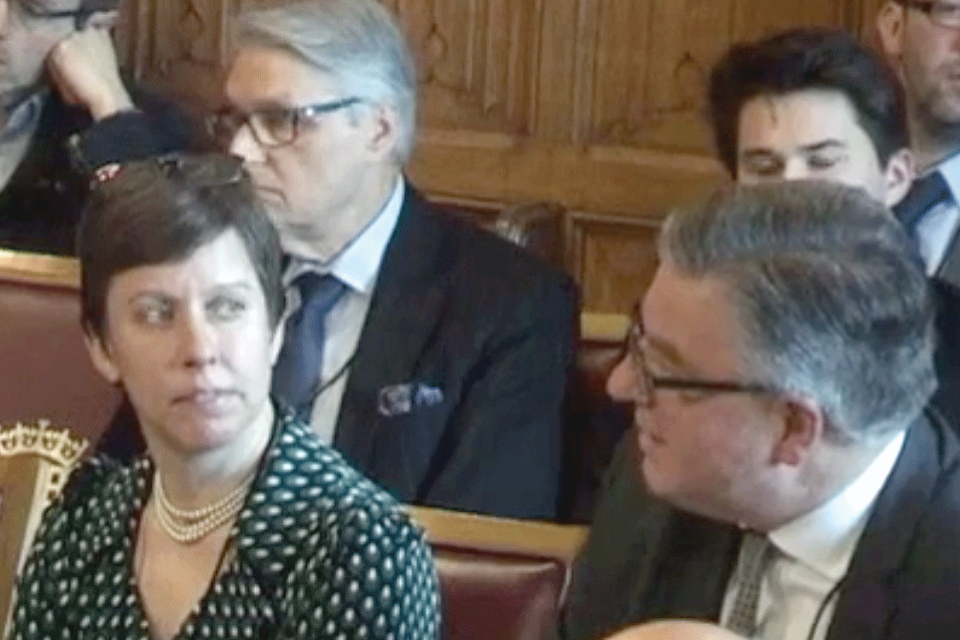
Chief Operations Officer Chris Pope speaks at a meeting of the Draft Registration of Overseas Entities Bill Committee
Following the release of the Panama Papers the public demand to know the people that benefit from holding property in corporations that are vested overseas is growing.
The release of our own overseas companies dataset in 2018 is contributing to the government response to that demand. We have also been working with the Department for BEIS as it shapes and brings forward new legislation that aims to bring greater transparency to the beneficial ownership of UK property-owning overseas bodies. Working collaboratively on the draft Registration of Overseas Entities Bill has involved legal and other experts from HM Land Registry, Companies House and other land registries alongside the department’s Bill team.
Simplifying fees

Mike Westcott-Rudd, Board Legal Adviser and Head of Corporate Legal Services
One of our most common requests for information is to check the accuracy of the fee. This costs us and our customers time and money. With more than 74,000 of these requests made this year alone, we know the fee structure can be complicated for our customers.
We are now embarking on a simplification of our fees. During the year we have secured the support of key government and industry stakeholders enabling us to publicly consult on our proposals in 2019/20.
The Government’s cyber plans
Our registers are part of the nation’s critical national infrastructure and so demand the highest levels of security. As our services become more digital and cyber threats more sophisticated, we must ensure our data remains secure.
The Cabinet Office-led cross-governmental improvement programme Transforming Government Security is introducing centres of excellence for expert security provision. We are an early adopter of this innovative and collaborative approach and we are also advised and tested by the National Cyber Security Centre.
Claims against the guarantee
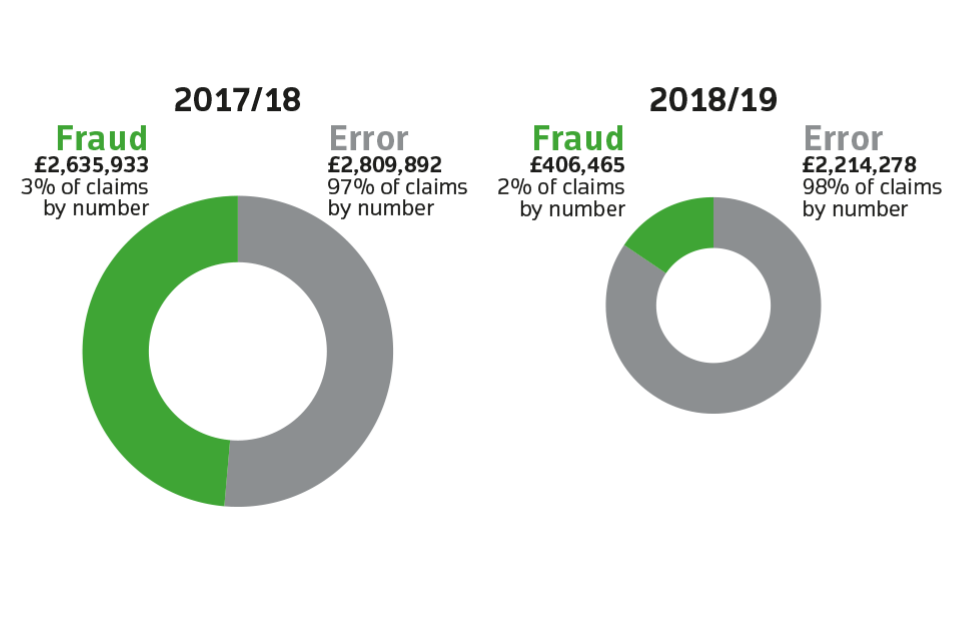
Award-winning apprenticeship programmes
Our 120 specialist lawyers work across our 14 offices. We continue to invest in their recruitment and training to ensure we have the best property and registration law experts in the country.
The Guardian Public Service Awards recognised our partnership with the Chartered Institute of Legal Executives (CILEx) to design a bespoke two-year apprenticeship in paralegal and chartered legal apprenticeships as an exemplar of providing entry level qualifications for existing colleagues. The two pilot schemes offer structured and progressive work-based training combined with external legal qualifications.

Nicola Housley of Leicester Office said:
I completed my law degree back in the day and for 13 years worked for Leicestershire Police. I was lucky enough to be selected for the apprenticeship and I’m really enjoying the course and the training. It’s amazing to think I can now qualify as a lawyer thanks to external training, and I hope to eventually obtain a position as a lawyer here.
Freezing assets to combat suspected crimes
HM Land Registry plays an important role in securing property which law enforcement agencies suspect of having been obtained through illegitimate means. Law enforcement agencies are able to obtain freezing orders to prevent a suspect disposing of assets while an investigation is underway. The agencies can apply to HM Land Registry for an entry to be made in the property’s register which will prevent the registration of any transactions affecting those properties unless a further order of the court has been made or the relevant agency consents.
Since 31 January 2018, the National Crime Agency (NCA) and other enforcement agencies have had the additional power to apply for an Unexplained Wealth Order (UWO) against certain assets connected to an individual suspected of involvement in serious crime. In February 2018, the High Court issued the first UWO against assets connected to Zamira Hajiyeva, the wife of an Azerbaijani banker. The UWO was supported by a freezing order against a house in Knightsbridge and a golf club in Berkshire, registered in the name of different foreign companies. The NCA then applied to HM Land Registry for an entry to be made in the registered title for the properties preventing their disposal while their investigation was taking place. Ange Woodhouse, a registration expert at our Telford office, entered a restriction in the registers for the properties and then notified the affected owner, effectively securing the property until the NCA completes their investigation.
Designing our digital future
John Abbott, Director of Digital, Data and Technology

It has been a busy year for HM Land Registry’s digital projects as the pace of our digital transformation increases. We have worked hard to improve our services for our customers and our colleagues, to lay the necessary foundations for our digital future and also enabling innovation to look at the land and property market of the future.
Exploring the future of the land and property market
This year, our groundbreaking research and development programme Digital Street successfully simulated the digital transfer of a real property.
We took an existing house sale and worked in parallel with the buyer, seller, conveyancers and bank to simulate that exact transfer digitally. We then used blockchain technology to securely record the transfer.
Working with the market has been key to that success, with more than 250 organisations engaged in our Digital Street research including Royal Bank of Scotland, IBM, the Law Society and HMRC alongside a wide mix of conveyancers, lenders, PropTech (property technology) start-ups, industry bodies and other government departments. All the members are helping to determine the future direction of the project and to explore and test our hypotheses on how best to use a range of new technology.
We proudly presented our work to an interested audience at the World Bank conference, sharing the lessons we learned and securing interest with other land registries who are experimenting with blockchain projects to work with us to find the best use for the new technology.
Another link in the blockchain
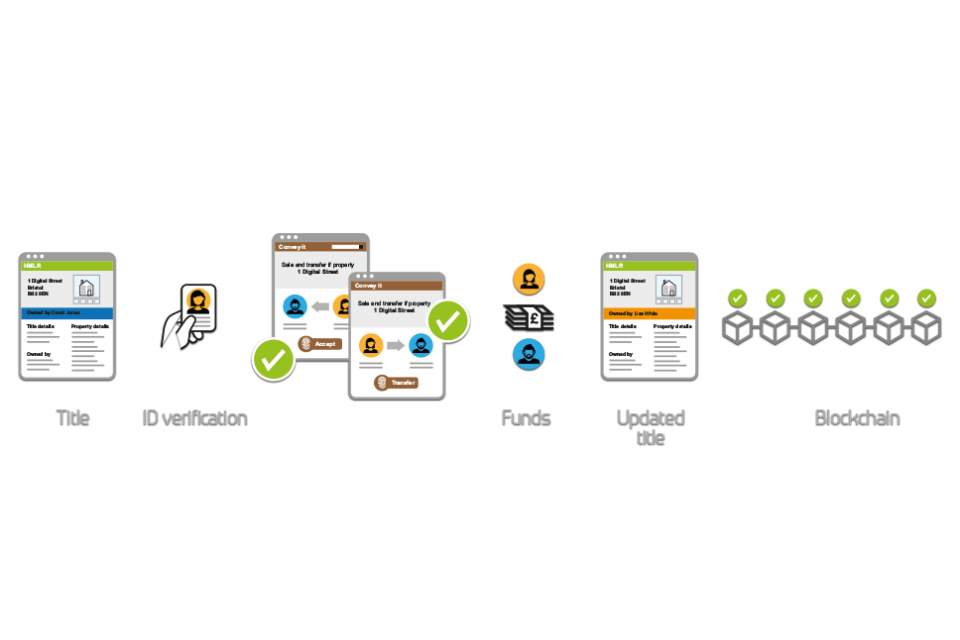
We have successfully prototyped the first digital transfer of property in the UK utilising blockchain, giving simultaneous visibility across multi-party transactional data. The prototype ran a real transfer of a semi-detached house in Gillingham, Kent, alongside the conventional paper-based process, to demonstrate a digital transfer. This provided greater clarity and efficiency for everyone involved, with each stage of the sale being open for all to view, and automatically completed once all the conditions for the sale were met.
Our prototype then automatically sent a notice to update the register. We worked with conveyancers Mishcon de Reya and Premier Property Lawyers, digital identity provider Yoti, payment specialist ShieldPay and HMRC, all members of our Digital Street community, to help design a complex and fully integrated system which made all aspects of the real-world transaction simpler, faster and cheaper for all parties.
Nick West, Chief Strategy Officer at Mishcon de Reya, said:
It is clear that, as it stands currently, real estate transactions are too slow. What’s exciting here is that this is a real-world application of blockchain technology in our legal market. If we can turn this proof of concept into reality it will be of significant benefit to anyone buying or selling real estate assets in the UK.
Stefan Godden, the seller of the house in Gillingham who took part in the trial, commented:
It was really straightforward. It shows how technology like this can help make everything so much quicker and you can see clearly what’s happening at every stage. If this is the way forward, it’s going to make everything easier.
Crafting digital foundations
Like any organisation that has existed for more than a century, our underlying data and technology infrastructure needs significant investment in order to meet our lofty aspirations. Historically, the Land Register has been a paper-based catalogue. In more recent years those paper records have become increasingly electronic but not truly digital. In order to realise fully the potential of this extraordinary national resource, we need a digital register that is accessible, available and interrogable.
We have explored the use of machine learning and advanced optical recognition tools that can assist n quickly digesting complex legal documents. The next stage of development will see priority datasets migrated from their current format to a new digital register. This will improve our ability to automate application processes and pave the way for remaining data to be added.
With this in mind we have also delivered a new underpinning IT infrastructure platform which enables our teams to develop software rapidly while reducing the costs of our IT estate. This new platform will replace the majority of our existing IT infrastructure and we have already migrated around 4m lines of code from our IBM mainframe saving almost £1m each year as a result.
But the danger for us would be to focus purely on technology. To develop our digital expertise we have invested in our colleagues to develop our skills, capabilities and ways of working. This investment in our people has enabled us to sustain the pace of our ambitious transformation programme but has also been recognised by colleagues across the industry. In particular we were very proud of our colleagues who received Women in IT award nominations and delighted to win two Real IT Awards this year.
Improving the experience
While our research into emerging technologies prepares us for the future, we know there are things we can do now to improve the services we provide.
Our registration experts process more than 20,000 applications every day. While the systems they currently use get the job done, we know they need to be improved. This myriad of systems will be replaced with a single, unified interface designed around the needs of our colleagues and customers.
We have already developed and tested a prototype system that our colleagues will be using to process applications early in 2019/20. The new system offers the opportunity to completely automate simpler requests and make even the most complex of our applications more straightforward.
Robotic Process Automation
We have also started using Robotic Process Automation for some of the more straightforward tasks, such as sending reminder letters. Together these digital tools enable our registration experts to focus their time on the more complicated land registration matters that need their expertise. By digitising the way we process applications we can work faster and make our customers’ lives easier.
We have been conducting user research with customers to improve our online business portal. The portal is our key browser-based channel for customers to search the Land Register and submit applications, with 32.3m requests received via this channel in 2018/19.
This year we developed a new service that will make the process of applying to update the register simpler for customers. It will also reduce errors and generate high quality data. We are on track to deliver this new service in the first quarter of 2019/20 with further enhancements to follow throughout the year.
Women in IT

Rachel Jones is HM Land Registry’s Head of IT Operations, managing around 130 people. Rachel oversees projects to introduce a greater level of automation while supporting existing casework systems, and has reduced overall operating costs. She also established HM Land Registry’s Women’s Network and has built strong relationships inside and outside of government. Her hard work throughout the year was recognised by the Women in IT Awards, as she was on the shortlist for CIO of the Year. Alongside Lauren Tombs, who manages the Digital Street research project, she was highlighted by the awards as a role model for women in the IT sector.
Their achievements this year reflect the great work and dedication shown across the Digital, Data and Technology teams.
Portal refresh
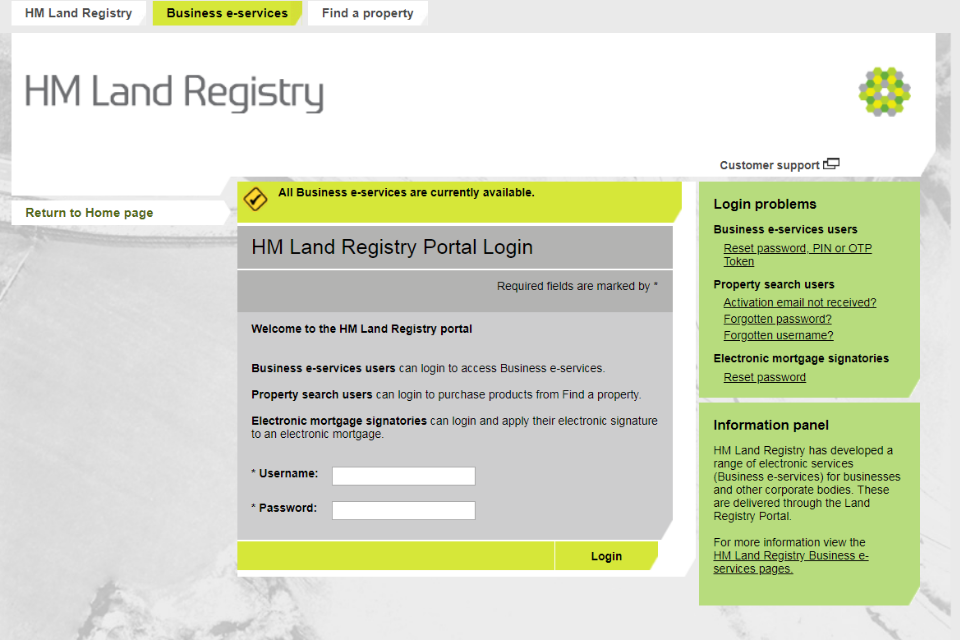
Work is underway to refresh our online business portal, our most used transactional channel for conveyancers and property professionals. This year we have spoken to those who use the service and will soon start work on improving guidance, navigation and task management. We will introduce a new way for users to make an application to change the register (currently known as an AP1 form) in the first three months of 2019/20, utilising online forms that allow clear guidance and checking applications for errors before they are submitted.
We have chosen the AP1 form as most of the applications submitted to us include an AP1 form. The form details fundamental information relating to the cases, with the necessary details about the property, the buyer or seller and who should be notified and how.
By starting with this form we will reduce errors in the most commonly submitted information, allowing caseworkers to devote their time to complex applications instead of having correct simple and avoidable errors. This new approach will also help us standardise the information we receive, for example names and addresses will always be submitted in the same format, paving the way for faster casework systems.
Jemma Rawle, Head of Residential Conveyancing and Associate at Foot Anstey in Taunton said:
I think that’s where the value is coming in for us. The step-by-step process is more user friendly than the form. It’s clearer. It’s definitely a step forward from what we’ve got at the moment.
Gareth Richards of Convey Law said:
We are delighted that HMLR are asking customers to assist on their portal refresh project and that they are committed to making the application process smoother and more user friendly for the customer. We can’t wait to see the updated version of the portal.
Using robots to speed up our processes
We have skilled workers completing simple, repetitive tasks using several overlapping systems. Robotic Process Automation is software that can be programmed to perform such tasks using existing systems. This will help us in the short term while we develop our new, holistic casework system. This year we started one robot on the laborious job of sending out around 1,000 reminder letters every day. This first robot (affectionally called ‘Reggie’) was able to free up five caseworkers, allowing us to redeploy them to other casework that required their attention.
After this successful initial testing we have invested in a further five robots to increase the efficiency savings thus far and explore what other simple administration tasks they can handle.
Digital mortgage
Use of our ‘Sign your mortgage deed’ service has continued to grow over the year. The digital service enables a paperless end-to-end remortgage application and approval process. Eighteen mortgage lenders including Nationwide, HSBC, NatWest and Santander have signed up. Our work reflects the increasing use of digital signatures and online mortgage applications in the mortgage market. Customers from NatWest were among the first to use the service.
Dan Salmons, NatWest Director of Mortgage Innovation, said:
Being able to offer a completely paperless remortgage journey is a huge step forward. It’s fantastic that the HMLR is being progressive in this area, offering complementary digital solutions that make those important life moments as seamless as possible for our customers.
Unlocking geospatial horizons
Andrew Trigg, Chief Geospatial and Data Officer

Geospatial data is estimated to be worth around £11 billion, according to research carried out this year by the Boston Consulting Group on behalf of the Cabinet Office. HM Land Registry holds some of the UK’s most valuable property data and our ambition is to become world leading in the way in which we allow our data to contribute to those potential gains.
Our registers describe land and property worth £7 trillion. So we know that if we enable best use of that data, the potential for the growing proptech industry to create radical change in the way services are provided and markets operate is very big indeed.
We are playing a central role with the Geospatial Commission in unlocking the potential of the nation’s geospatial data. We have prepared and released new datasets that will unlock further value to the economy. We are also learning from the new challengers in the marketplace as to what uses the data could be put to. We have welcomed our third new cohort of proptech innovators and entrepreneurs onto our ground breaking incubator programme called Geovation.
By partnering with other bodies, creating growth opportunities for innovators and releasing more data, we continue to take a leading role in not just underpinning our economy, but helping it to thrive and grow as part of a new digital revolution.
Unlocking the value of the nation’s land data
The Cabinet Office established the Geospatial Commission in 2018 to shape and deliver the UK’s Geospatial Data Strategy to promote better use of geospatial data.
The commission identified us as a key partner body, alongside five other national holders of important data: Ordnance Survey, the British Geological Survey, the Valuation Office Agency, the UK Hydrographic Office and the Coal Authority. We are collectively known as the ‘Geo6’.
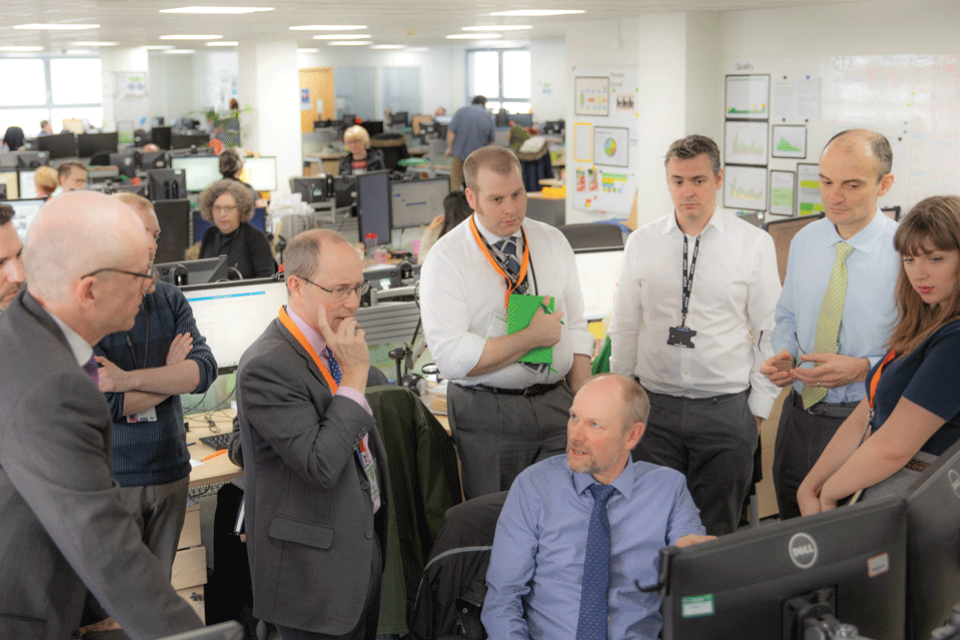
Croydon Office registration expert Ian Thomas (seated) briefs Geospatial Commission Chair Sir Andrew Dilnot (fifth from right) while (from left) Mike Harlow, commission Head of Public Sector Geospatial Policy Jamie Clark, John Abbott, Andrew Trigg and commission Secretariat and Policy Officer Ellen Bentley look on
The Geo6 have focused this year on how we can practically unlock the value in the data we collectively hold. We have already delivered a harmonised Data Exploration Licence, a joint Data Catalogue and developed proposals for further linking of data content.
We have contributed to the Geospatial Commission’s strategic thinking and plans. These will help make the most of the opportunities presented by the geospatial data we and others hold and will also help to provide a foundation for a new national geospatial infrastructure.
New data releases
The value of the datasets we released last year continue to demonstrate their impact as corporate ownership of land and property remains an area of considerable public interest. We have conducted research with a range of stakeholders to develop a roadmap that prioritises the publication of the datasets that matter most to them – that will drive better and different public and market services.
In March we released data on the requests for information (requisitions) dataset which provides details of the number of requests we have to send out for further evidence in support of applications. It covers our top 500 customers. We wanted our customers to see the variation in numbers of requisitions we have to raise before completing applications to change the register. Reducing the numbers of requisitions will improve the time taken to complete an application.
Next year we will release a number of key datasets that our users tell us will continue to disrupt and positively impact the property market and the economy more generally:
-
Registered leases dataset – providing details registered leasehold properties. There is high demand for this data from search companies, lenders, credit referencing agencies, and estate agents. It has also been singled out by the Ministry of Housing, Communities and Local Government’s research as having the potential to drive innovation in the homebuying process
-
Daylist dataset – providing a list of applications and searches received daily by HM Land Registry. Our research suggests this will be of great interest to those in the conveyancing industry who are interested to know the state of progress of transactions. It will also be of interest to those in the economy more generally who would value knowing when property is changing hands;
-
Restrictive covenants dataset – restrictive covenants on property titles restrict their use in some way. Early awareness of restrictive covenants can influence purchasing and development decisions, saving wasted time and resource for homebuyers, conveyancers and developers. The publication of this data will actively reduce the number of failed transactions and can be used to outline patterns of regional issues surrounding land use restrictions.

The Geovation Hub in Clerkenwell, central London
Inspiring the next generation
We continue to support PropTech start-ups through our Geovation programme. Our joint initiative between HM Land Registry and Ordnance Survey continues to drive and encourage innovation and collaboration, utilising our combined location and property data. Since October 2017, we have invested £160,000 of grant funding in 14 PropTech companies who have raised more than £6 million of third-party investment.
The programme encourages and assists start-ups in realising their potential. It offers data, insight and office space, and puts the young companies in touch with a network of established entrepreneurs and industry leaders who offer mentoring and advice.
Importantly, we learn a lot too. The start-ups shine a light on future uses of our data. That tells us how to direct our investment in its quality and accessibility, so we can enable the property market to be the best it can be.
A trusted source of national house price information
The UK House Price Index is a vital economic indicator, produced in collaboration with Land and Property Services Northern Ireland, the Office for National Statistics and Registers of Scotland. In September 2018 the Office for Statistics Regulation identified the index as a National Statistic. This recognises the index as meeting the highest standards of trustworthiness, quality and value, as defined in the Code of Practice for Statistics. In February the Bank of England announced the index to be their preferred measure of house price inflation.
Ed Humpherson, Director General for Regulation at the Office for Statistics Regulation, said:
The assessment team has been impressed by the commitment shown by the UK House Price Index working group and the collaborative approach taken to introduce a range of improvements in response to our assessment. This approach has ensured that the index is produced in a way that maximises its public value and gives users confidence.
Average residential property prices
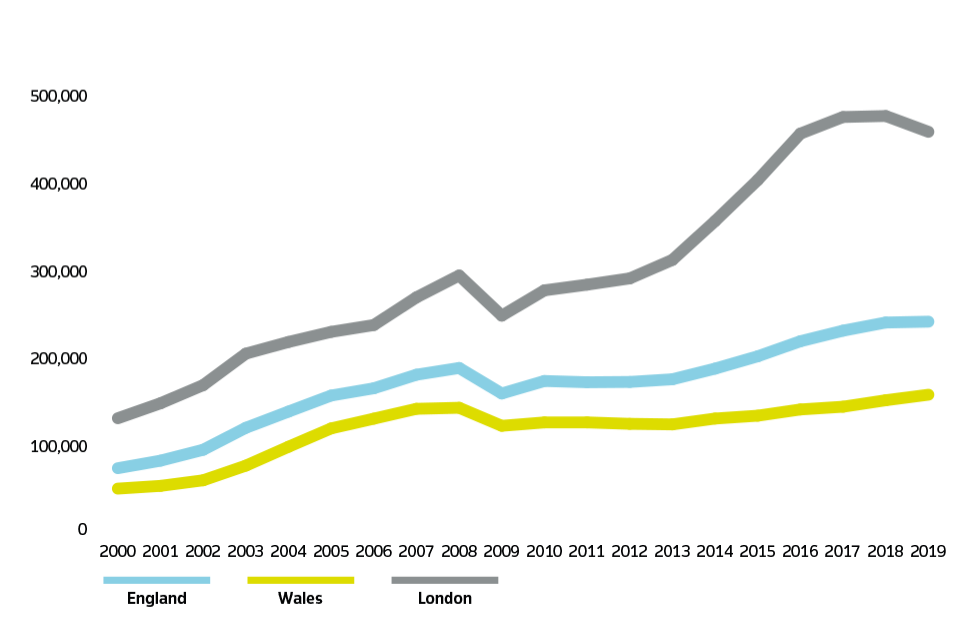
Geovation 2018 – last year’s cohort
Hipla
Adam Phillips is co-founder of PropTech company Hipla, which has created a Home Buyer Passport to improve transparency in the homebuying process.
Receiving backing, guidance and help from Geovation has helped our early-stage start-up gain a much steadier footing than it otherwise would have done. Its help with funding, office space, data and market insights has been invaluable. The support has meant we are now in a much better position to deliver on our objective of improving the homebuying process.
Thirdfort
Olly Thornton-Berry is co-founder of PropTech start-up Thirdfort, which works with lawyers to hold money securely during property transactions.
Geovation has been immensely helpful. It supported us from incubation to a business with over £670k in funding, a testable product and two new in-house developers. We now feel we have a foundation to grow from, and Geovation has been integral to that foundation.
Geovation 2019 – this year’s cohort
On 15 April 2019 the latest intake of PropTech start-ups to join Geovation were announced.
DronePrep
DronePrep uses location data to open up new low-level airspace access possibilities by connecting drone pilots to landowners to share and agree flight information.
Winston
Winston is a digital concierge supporting the home of the future. Customers will make requests through their platform or via their bespoke messaging channel.
Property-Markets
Property-Markets is a professional property comparison website which aims to take the hard work out of searching for and analysing property, saving time, money and effort. It has more than 30,000 properties for sale in London.
RenKap
RenKap is an online marketplace working to alleviate the housing crisis by scaling the delivery of high-quality homes for those locked out of the housing market. They target the small sites that are difficult and time consuming for local authorities and housing associations to deliver, providing local homes for local people through shared ownership and rent to buy.
Transforming together
Karina Singh, Director of Transformation

HM Land Registry is a large and complicated organisation. We serve a complex and evolving market which has changed beyond recognition in 157 years.
Our transformation touches everything we do. We are changing our systems and processes and investing in the IT infrastructure needed to support new digital services. To better support the UK economy, we are reformatting and opening up our data and simplifying our fee structure.
We must also ensure our colleagues are empowered to deliver the extensive changes required and are involved in shaping the kind of organisation we want to be in the future. We are changing the way we recruit, manage, lead and develop colleagues.
Involving colleagues
Involving colleagues from across HM Land Registry and wider government has helped us to increase the pace at which we deliver. Local change manager networks are supporting new changes and ensure feedback flows from the front line to those designing and implementing change.
Our leaders have undergone initiatives to develop change management skills. We are looking at ways to embed continuous improvement and agile methodologies across the organisation. This will ensure we deliver the myriad of upcoming changes in the right way.
Front-line colleagues have been involved in changes which make their day-to-day work easier. This has helped increase productivity by an extra 151 full-time equivalents.
Importing world-class best practice
We are also looking to understand and import world class best practice from outside of HM Land Registry. This year we have talked to land registries around the world. Closer to home we have spent a lot of time with local authorities and our customers who have helped us to refine our new products, services and channels. Projects such as Digital Street have seen close collaboration with key players across various markets. And our legal professionals have worked across government to protect the integrity of the register in a more digital world.
There is much work to be done if we are to achieve all that is set out in our Business Strategy. We are very clear that we will succeed only if we take the journey to transformation with all our partners.
Simply put – we will not transform unless we collaborate.

Registration experts at work in our Nottingham office
Our transformation programmes 2017-22
Digital – providing new digital services to all our customers that make it easier for them to work with us while also increasing our efficiency.
Data And Data Publication – unlocking the vast amounts of property information to increase its value for the UK and the digital economy.
IT Infrastructure – creating a more resilient, secure, and cost-effective IT infrastructure, keeping our data secure and easily accessible.
Service Improvement – creating more consistency in the way we do things across operations, including improving current processes, casework systems and the way we allocate work.
Customer – putting customers at the heart of our services to become faster and easier to do business with.
Local Land Charges – improving the homebuying process by making Local Land Charges (LLC) results instantly available.
Brilliant By Design – creating and implementing a single national approach to operations underpinned by a culture of continuous improvement across all 14 locations.
Local Land Charges
The digital Local Land Charges service went live in July 2018 with Warwick District Council’s data the first to be transferred to the new register. This marked a milestone in making the conveyancing process simpler and faster. Local land charges search results for the district can now be provided in seconds rather than days or weeks.
We worked with customers, central government and property sector trade bodies to design a new service that was as user friendly as possible. It has been well received by users and is delivering on our ambition to make buying homes simpler, faster and cheaper for citizens.
Since the launch, four other local authority areas’ data has been added to the digital register, with more local authorities eager to migrate having seen the benefits it has brought to Warwick, Liverpool, City of London, Blackpool and the Isles of Scilly.
We are collaborating with local authorities to transform their existing local land charges data. Their data is held in a variety of formats including paper and microfiche. We help them digitise it, ensuring its accuracy and adding spatial extents before migrating it to our central register.
We are now working with PropTech companies to explore how this transformed and cleansed data can add even greater value to the property market and the wider economy.
Richard Steele, Corporate Spatial Data Manager at the City of London Corporation, said:
Previously, our local land charges data was held in a mixture of paper and digital systems. Before migrating all the information to HM Land Registry’s register, we have digitised and accuracy-checked all the data. This helps to reduce business risk for future property transactions in the area. By taking part in the process the turnaround times for local land charges search results for properties in the City will be reduced from days to seconds.
Warwick District Council’s Chief Executive Chris Elliott said:
As a forward-looking council aiming to provide the best possible service to all of our customers, we very much welcome any measures which will speed up the process of buying a home. Opening up our data to HM Land Registry will be a huge benefit not only to those wishing to purchase a home or land in our district, but also to our busy planning team.
Stephen McCluskey, Operations Director for SearchFlow, said:
The digitisation of Warwick District Council’s Local Land Charges data marks the start of a major milestone in our industry. This aims to improve the speed of delivery and we are proud to support our clients in seamlessly accessing this data, without them having to change any of their working practices.
Tom Ansell, Head of Conveyancing at Brethertons LLP Solicitors, said:
We…couldn’t believe how quickly the documents were returned and the quality of the reports therein. We can already see how this service will be such a benefit to our customers, speeding up transaction times and furthering their overall positive conveyancing experience.
Andrew Lloyd, Managing Director of Search Acumen, said:
It is early days, but we think the ability to immediately execute LLC searches will completely transform UK property transactions. It’s no surprise that LLC searches have too often been the fly in the ointment for both residential and commercial property transactions. Property professionals have been at the mercy of a fragmented process that can result in a sub-optimal service for their clients. The launch of the central digital register is a big step towards getting as close to the bestcase scenario as possible, and even going one better through digital technology.
Performance analysis and financial review
Iain Banfield, Chief Financial Officer

I am delighted to have joined HM Land Registry at such a pivotal stage in its Business Strategy. Our key financial challenge is about striking a balance: we need sufficient resources to protect the integrity of the register; we also need enough investment to realise the huge potential of our transformation programme. To this end, our financial strategy seeks to ensure our longer-term plans are sustainable from the income that we will generate over the economic cycle.
We will transform and modernise the services we provide. At the same time, we will continue to deliver our core statutory duties, which underpin the effectiveness of the UK housing market.
Overall, this has been a year of strong financial performance for HM Land Registry. In 2018/19, we invested a total of £31.8 million in our transformation programme. We also returned a dividend to the Government of £27.3 million and retained an annual surplus of £5 million.
| 2017/18 £m | 2018/19 £m | Variance (17/18 to 18/19) % | |
|---|---|---|---|
| Operating income | 319.9 | 323.2 | 1 |
| Total costs | (266.4) See note 1 | (290.9) See note 2 | 9.2 |
| (Of which operating costs) | (260.2) See note 1 | (292.2) | 12.3 |
| Surplus before dividend | 53.5 | 32.3 | -39.7 |
| Dividend | (28.7) | (27.3) | -4.9 |
| Retained surplus | 24.8 | 5.0 | -79.9 |
| Capital expenditure | 12.8 | 16.8 | 31.3 |
| Net assets | 446.4 | 452.9 | 1.5 |
Note 1
In 2017/18, miscellaneous income was netted off operating costs, rather than reflected as operating income. However, in 2018/19, it was instead included as operating income. The 2017/18 values for operating income, total costs and operating costs have therefore been restated here to allow for like-for-like comparison.
Note 2
In 2018/19, operating costs exceeded total costs due to the latter netting off one-off receipts of £3.5 million.
Operating income
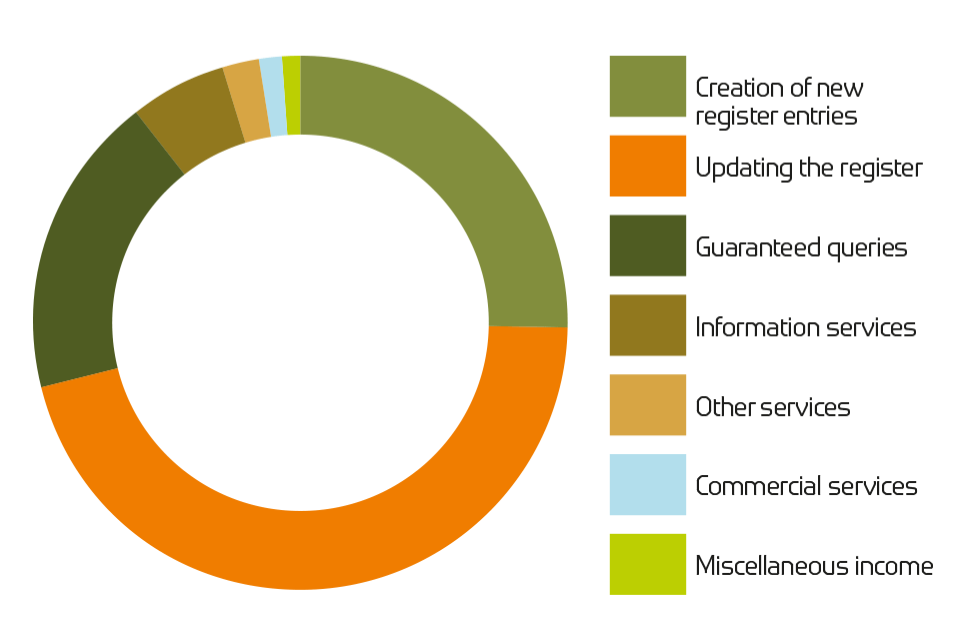
The property market in England and Wales remained robust in 2018/19, resulting in a year-on-year increase in operating income of 1.0%, to £323.2 million.
As in previous years, almost half our operating income was driven by updates to existing titles in the register, which accounted for £148.6 million. The creation of new register entries (such as first registrations, transfers of part and new leases) generated income of £82.0 million. Within these figures, there continues to be a shift towards the remortgage market.
Our other major income came from guaranteed query services. These are critical steps in every property transaction and where we see our largest volume of service demand. However, since they are largely automated, they do not carry as high a fee as our register change services (which require input from our expert professionals). In 2018/19, guaranteed query services accounted for £58.9 million.
Information services enable users to go online to get a snapshot of any registered plot of land or property. We charge for some of these – such as views of the register – as well as offering free online services, including MapSearch and Property Alert. Information services generated £19.5 million in 2018/19. Together (and adjusting for refunds), the three core registration services above generated £308.7 million (95.5%) of £323.2 million of operating income in 2018/19.
We also provide other land and property services. Our digital Land Charges service protects interests in unregistered land and we maintain the bankruptcy index for England and Wales. Our Agricultural Credits Department maintains a register of short-term loans secured on farming stock and other agricultural assets. Together these generated £7.0 million.
Finally, we offer free and commercial data services for customers in the property market and elsewhere in the economy. Income from the commercial release of our data generated £4.5 million in 2018/19. Our ambition is to release all of our publishable and available data by 2021. Our income will be used to support the release of further datasets. Aside from income from our services, we received miscellaneous income of £3.0 million, the vast majority of which comes through the investment property we hold, which we let on a commercial basis.
Operating costs
2018/19 has seen a 9.2% increase in our cost base. This was driven by increased investment in transformation in line with the profile in the Business Strategy, but also through expanding caseworker capacity to address historic under-resourcing and to meet existing demand.

We recruited more expert colleagues and funded increased overtime to help manage the backlog and improve our speed of service. This contributed to an increase in staff costs for our business-as-usual activity, rising from £180.2 million in 2017/18 to £195.4 million in 2018/19. Non-staff business-as-usual costs totalled £60.4 million (2017/18: £53.4 million), including spend on: property and facilities management; IT services, including maintenance of equipment and licences; and various contracts with third party suppliers, relating to document storage and retrieval, document scanning, and mapping services from Ordnance Survey. Impairment and depreciation costs included within the non-staff costs increased from £5.0 million in 2017/18 to £7.8 million in 2018/19.
There was also £98,000 included in respect of the statutory audit for 2018/19 by the National Audit Office and Comptroller and Auditor General (C&AG): £92,000 fee for 2018/19 and an extra charge of £6,000 due to undercharging in 2017/18.
Improving our services
Our strategy depends on investment in transforming the services we provide and how we provide them. In 2018/19, we invested £26.9 million of resource (including £10.9 million of staff costs) in our ambitious change programme.
The majority of this spend relates to the continuation of our Digital and Data Programmes. The overall aim of these is to modernise HM Land Registry and improve the range of, and access to, our data. It will enable us to provide better, faster and more efficient services, at lower cost.
We also invested in improving our existing services, systems and casework processes as part of our Service Improvement Programme and in our Customer Programme. The latter is improving critical elements of how we manage customer contact. These include refreshing our online business portal and improving our customer relationship management system. In addition, we invested in our IT infrastructure, which will enable us to move some of our services to the cloud, as well as work towards consolidating our data centres from three sites into two.
Guaranteeing the integrity of the register
Alongside our core business costs and transformation programme, our state-backed guarantee of title helps to underpin the integrity of the register. It provides protection for victims of fraud or unforeseen errors. In 2018/19, £7.0m of our operating costs related to such indemnities. This consisted of both £2.6m paid out against 882 claims, and movements in the provision over the course of the year, based on advice received from the Government Actuary’s Department:
- a £400,000 movement in the outstanding claims provision, relating to the estimated value of claims received before the year end, but not yet settled
- a £4.0 million movement in the ‘incurred but not reported’ (IBNR) provision, relating to potential claims as a result of existing (but as yet unidentified) errors
Further information on outstanding claims and IBNR provisions – including sensitivity analyses that reflect the estimated nature of the IBNR liability and susceptibility of the provision to fluctuation – can be found in note 16.2 in the accounts, along with the changes in methodology compared with the 2017/18 Annual Report and Accounts. See Appendix E for further detail on claims paid.
Commercial services
Finally, operating costs included £2.5 million to support our commercial services, of which £1.2 million were staff costs.
Non-operating income and costs
The major component of our non-operating costs is our Local Land Charges Programme, which began a live service in 2018/19. These costs (£4.7 million) include £1.6m of staff costs and are reported net of the associated income.
Another non-operating cost was the interest payments associated with our finance leases (£600,000), while a refund from the Civil Service pension provider served to reduce our non-operating costs by £3.5 million.
Finally, we generated non-operating investment income (£3.1 million) from the interest gained through our approach to Treasury Management.
Capital and reserves
Total capital expenditure was £16.8 million, including £4.9 million on the transformation programme. This was mainly on IT, software and capitalisation of Local Land Charges development costs. Of the total spend, £3.0 million related to tangible assets and £13.8 million to intangible assets.
After total income and costs, a dividend payment of £27.3 million (2017/18: £28.7 million) will be made to HM Treasury, which results in a retained surplus of £5.0 million. (The drop in dividend of £1.4 million compared to 2017/18 reflects changes in the Consumer Price Index on which it is based.) Combined with a £2.3 million gain in the Revaluation Reserve, a comprehensive surplus of £7.3 million has been achieved, resulting in net assets of £452.9 million.
Corporate financial targets
| 2018/19 | 2017/18 | |||
|---|---|---|---|---|
| Actual % | Target % | Actual % | Target % | |
| Percentage return on average capital employed | 6.0 | 5.4 | 11.1 | 4.3 |
Reclassification of HM Land Registry
In October 2018, the Office for National Statistics reclassified HM Land Registry into the central government subsector for national accounts’ statistical purposes, in accordance with the provisions of the European System of Accounts 2010. We were previously a public (nonfinancial) corporation. As a result, it is possible that the government may revoke our trading fund status as from April 2020. We would then enter the parliamentary vote-funding regime from 2020/21 and our finances would form part of the financial statistics relating to central government.
We are in discussions with HM Treasury to make sure any future financial framework provides the flexibilities we need in order both to continue our functions and meet our ambitions.
Movement in net assets 2018/19 (£ million)
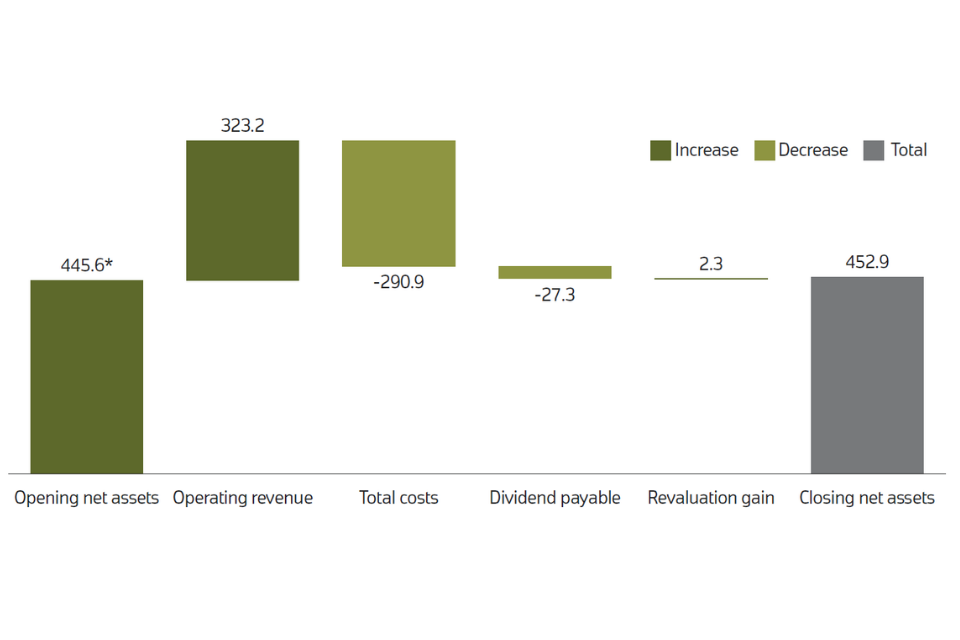
*Opening net assets were adjusted to reflect application of IFRS 15, as explained in note 11 to the accounts
Our performance
Our KPIs are set with the intention that they will remain key measures of business performance for the lifetime of the Business Strategy, through to 2021/22. Our KPIs are split between four of the six strategy areas. The level of ambition and performance against our targets has increased since we launched our strategy in 2017.
We have 14 KPIs against our strategic priorities to monitor for 2018/19.
Brilliant at the basics – more customer focused
The percentage of customers who rate our overall service as good, very good or excellent to be at least 92%
- Target: 92%
- Performance: 92%
| 2016/17 | 2017/18 | 2018/19 |
|---|---|---|
| 90% | 92% | 92% |
Work with conveyancers to reduce the average rate for all requisitions from 20% to 15%
- Target: 15% (from 20%)
- Performance: 18.94%
Brilliant at the basics – more efficient and upholding our values
The average cost per register update to be reduced from the 2017/18 target by 3% in real terms
- Target: 3% reduction
- Performance: 3.3% reduction
| 2017/18 | 2018/19 |
|---|---|
| £25.54 | 3.3% |
Complete register queries within two days
- Target: 95% in 2 days
- Performance: 98.38%
Complete register updates within five days.
- Target: 95% in 5 days
- Performance: 96.12%
| 2016/17 | 2017/18 | 2018/19 |
|---|---|---|
| 79% | 97.5% | 96.12% |
Complete complex register create cases within 25 days
- Target: 95% in 25 days
- Performance: 50%
| 2016/17 | 2017/18 | 2018/19 |
|---|---|---|
| 23% | 45.5% | 50% |
Substantive registrations to pass at least 98% of defined quality checks
- Target: 98%
- Performance: 97.78%
| 2016/17 | 2017/18 | 2018/19 |
|---|---|---|
| 98.30% | 98.41% | 98.78% |
World leading through Digital Street
The Digital Programme will improve services and deliver a productivity saving of 65 full-time equivalents (FTEs)
- Target: 65 FTEs
- Performance: 66 FTEs
Average external e-services availability to be at least 99.7% during published service hours
- Target: 99.7%
- Performance: 99.78%
| 2016/17 | 2017/18 | 2018/19 |
|---|---|---|
| 99.89% | 99.92% | 99.78% |
Local Land Charges service to be live and providing services to customers
- Target: Live by 31 December 2018
- Performance: Met
Expert people
Staff engagement score to be in the top half for the Civil Service for organisations of equivalent size and nature
- Target: Top 50%
- Performance: 3rd out of 20
| 2016/17 | 2017/18 | 2018/19 |
|---|---|---|
| 56% | 60% | 61% |
Engagement score for leadership and managing change to be 10 percentage points higher than the 2016 baseline
- Target: Top 43%
- Performance: 45%
| 2016/17 | 2017/18 | 2018/19 |
|---|---|---|
| 33% | 41% | 45% |
Increase the number of women in the middle and senior management grades by 50
- Target: 959 women in the middle and senior management grades
- Performance: 968
Financially strong
Productivity to increase by 2.7%
- Target: 2.7%
- Performance: -2.6%
Our performance in depth
This has been a year of strong performance with HM Land Registry successfully meeting 11 out of 14 of our KPIs and 42 of our 56 milestones. In particular, 98% of all our applications were met within service standard and there has been year on year improvement on performance against our defined quality checks, colleague engagement score and leadership and managing change.
Our milestones
Our Business Plan for 2018/19 outlined a number of key milestones against each of the strategy areas we tracked progress against. These milestones covered a vast array of project and business as usual work and included some areas not covered by our KPI. For example, under ‘A comprehensive register’ there were five milestones looking at the registration of public land, all of which were met. At the end of the year we met 42 of our 56 milestones. Eleven of these are categorised as ‘not met’ or ‘partially met’. They include areas where we delivered after the original deadline that was set. Three milestones were no longer applicable and include instances where targets had changed mid-year.
Brilliant at the basics: more customer focused
Customer satisfaction: To make sure our decisions are based on an understanding of customers’ needs and their expectations of us: We commission our research partner, Ipsos Mori, to survey our customers every quarter and ask them how they rate our overall service. A total of 1,200 of our customers were surveyed as part of the 2018/19 KPI, the same number as in 2017/18.
Our target was to have 92% of our surveyed customers (up from 90% in 2017/2018) rate our service as good, very good or excellent against a five-point scale. In February 2019, we achieved a 92% year-end satisfaction rate, which includes 33% rating us as excellent, maintaining our performance from last year. This KPI will roll forward into 2019/20. In parallel to the current KPI we will trial a new customer satisfaction tracker including updated survey and sampling techniques. This updated approach will better reflect our future customer base and operating structure. This is with the intention of introducing it as our new Customer Satisfaction KPI for 2020/21.
Requisition reduction: To enable us to process applications faster, minimise cancellations and ensure that customer receive the best value from the professional services they pay for: Requisitions are enquiries raised by caseworkers against applications that are lodged with incomplete/missing information and other discrepancies. The volume of requisitions received is hindering our ambition to make dealings with us quick and simple and represents an ongoing burden/risk to HM Land Registry and its customers. This year’s KPI to reduce requisition rates to 15% from the 20% seen at the end of 2017/18 has not been achieved. Although a great deal of work has been done in 2018/19 to prepare the market for improvement, this has not yet been fully reflected in the overall level of quality of the registration applications we receive.
Internally we have worked to improve our own consistency in the raising of requisitions and thereby improve the data we are sharing with some of our customers. Our caseworkers underwent new training in the course of the year to improve consistency and, while there is more to do, significant improvements have already been made. For example, we have reduced the use of non-standard requisitions to virtually zero, meaning our customers are now receiving more consistently worded and clearer feedback when we raise requisitions.
Externally, we have worked with the customers who lodge the most applications to improve quality, and in some cases requisition rates have fallen. We have delivered new training and support tools for our customers that have had significant take-up. We have implemented new policies for rejection in certain types of application and are trialling new ways of dealing with requisition points that recognise the issues our customers face in obtaining evidence from third parties. We are working with regulators and membership bodies to help improve the quality of applications through the sharing of data and collaborating in joint training and development activities. Towards the end of 2018/19, we published requisition data relating to our top 500 customers by volume of applications lodged. We will continue to monitor performance against requisitions as a KPI next year.
Brilliant at the basics: more efficient and upholding our values
The average cost per register update reduced from 2017/18 by 3%. To measure the efficiencies and savings made on register updates in part through the digitisation and automation of daily transactions: This KPI measures the year-on-year change in the cost of processing register update applications. We use a full costing methodology. In 2018/19, the cost fell by 3.3% against the target that was set for 2017/18.
Speed of service standards
To measure the efficiency of our operations and the service we provide to our customers: Our caseworkers processed 15.1 million register queries and 4.96 million applications to change the Land Register in 2018/19, with 4.46 million of the changes being mostly ‘straightforward updates’ (excluding bulk register updates) and 500,000 being more complex register create processes such as first registrations, new leases and splitting titles.
Our speed of service targets are a fundamental part of our ambition as outlined in our Business Strategy – to become the world’s leading land registry for speed, simplicity and an open approach to data. In 2018/19:
- 14.8 million register queries (includes office copy requests and property searches for example) were processed within the two-day service standard 4.3 million register updates (excluding bulk register updates) were processed within the 5 day service standard
For the more complex register create applications, we have not yet consistently met the service standard. A total of 250,000 of our complex register create cases 46 were processed within 25 days, which accounted for 50% against our target of 95%. This was partly due to our more experienced caseworkers being involved in the upskilling of our new colleagues. This will secure our ability to ensure service standards for our more complex work will be improved in the future. We met the standard for first registrations and creation of new title entries for major new build developments developer work but not for the complex business of other new title creation. On average, these were dealt within 52.05 days which is an improvement from 62.77 days in 2017/18.
We will maintain our two and five day services standards for 2019/20. Our 25-day target for the more complex register creation work will focus on first registrations and creation of new titles with a new KPI being developed to focus specifically on the remaining backlog.
Providing assurance for our customers
To provide a consistent experience for our customers, improve accuracy and make sure the quality and integrity of our service and of the register are always maintained: We continually challenge ourselves to ensure we are providing a quality product by carrying out the right checks.
Our current checks include proprietor names, addresses and price paid. We check 1% of applications completed over 5 consecutive days, twice a month. Any errors identified during this process are corrected. At the end of 2018/19, we had checked 11,285 applications and found only 137 titles with errors. This gave an accuracy rate of 98.78%, and a marginal improvement of 0.37% from 2017/18. The KPI will be maintained for 2019/20 with checks against an expanded set of criteria.
World leading through Digital Street
Deliver a productivity saving of 65 full-time equivalents (FTEs)
To measure efficiencies and savings made through the Digital Programme: We achieved a productivity saving of 66 FTEs. Next year, we will focus on productivity savings resulting from the Transformation Portfolio. We will also develop a clearer KPI to measure the impact of our transformation on the wider economy, this is with the intention of measuring performance from 2020/21.
External e-services availability
To measure availability of our services for our customers. Currently we have a target to ensure our external e-services are available at least 99.7% of times against advertised service hours. We are pleased to say we have met this target in each of the last two years we have been monitoring. This target has been increasing each year and for the 2019/20 financial year we will be increasing it again to 99.8%. At the same time, we will continue to invest in our IT infrastructure to develop new services and functionality that will transform the way the organisation works.
Local Land Charges (LLC) to be live
To ensure the delivery of HM Land Registry’s fourth register: The LLC service went live in July 2018, providing customers with live LLC searches as part of the conveyancing process. In 2019/20, in order to measure the improvements, we make to our systems and processes, we will introduce a new target which will look at the number of applications processed automatically through the digital mortgage service.
Expert people
Colleague engagement
To measure and drive improved engagement with our people and enhance our culture of leadership and change management: The engagement and commitment of our colleagues is crucial to our ability to achieve our ambitions. This is reflected in our target to improve our employee engagement score to be in the top half for the Civil Service for organisations of equivalent size and nature. Prior to launching our Business Strategy, our People Survey results showed our engagement was at 56% in 2016.
Since launching the strategy, not only have we improved our engagement score, which now stands at 61% for 2018, we achieved our target to improve the positive scores for leadership and managing change by at least 10 percentage points one year early, to 45%.
Our overall engagement score means we ranked third of 20 equivalent size and nature organisations. These results demonstrate that HM Land Registry is an organisation on the rise. The positive results are a reflection of the culture we are developing in the organisation but there is still more to do. In 2019/20 we will continue our focus on our future culture to improve employee engagement and make HM Land Registry an even a better place to work.
Increase the number of women in the middle and senior management grades
To ensure we make continued career progression opportunities available. For the first time in 2018/19 we introduced a target to increase the number of women in middle and senior management grades by 50. We exceeded the target by nine. As well as maintaining this KPI for 2019/20, we will also introduce a target which will look to increase the numbers of black, Asian and minority ethnic colleagues in the management grades, where the evidence suggests the current pipeline needs to be strengthened.
Financially strong
Productivity to increase
To measure efficiencies made through automation and digitisation: The KPI has been missed in 2018/19 with productivity under this measurement at -2.6% for the year. This primarily reflects the additional overheads associated with the change programme, for example the training overhead as executive caseworkers train new recruits, where the benefits will accrue in future years.
Sustainability performance
This report is delivered in line with the 2018/19 guidelines supplied by HM Treasury.
We use our environmental management system to make sure we are working towards the required targets set as part of the Greening Government Commitments (GGC) and the Greening Government ICT requirements and, to manage the delivery of land registration in an environmentally responsible way.
We are accredited to the environmental ISO14001 standard which independently ratifies our performance across the full range of sustainability activities within the organisation.
Compliance with environmental legislation is managed by our sustainability manager through the Sustainability Governance Framework and compliance meetings with our facilities management provider.
Climate change
The GGC targets continue to drive government to be more sustainable and ensure the requirement of the Climate Change Act (2008) of a reduction of 31% by 2020 in greenhouse gas emissions is delivered.
We consider climate change impacts during the delivery of building works and projects. Information gathered in building condition surveys and forward maintenance plans is used as part of our sustainability reduction strategy while carrying out major refurbishments and relocations or when delivering significant building plant replacement.
Biodiversity and the natural environment
We continue to make improvements where we can to grounds maintenance at our offices with an emphasis on habitat creation when replanting occurs.
Carbon
Gross emissions have improved to -63% over the 2009/10 baseline.
Consumption of both electricity and gas has fallen over the last year partially due to the introduction of more energy efficient equipment and the rationalisation of one of the HM Land Registry Data Centre locations. The reductions have continued despite continued recruitment and extended office opening hours.
The cost of the Carbon Reduction Commitment to the organisation was £86,000.
The greenhouse gas target set for all partner organisations in the Department for Business, Energy and Industrial Strategy (BEIS) is to reduce emissions by 40% by March 2020 over the baseline data for 2009/10, which we are currently meeting.
Waste
Waste management is delivered through two routes. Confidential business paper waste is managed through a confidential waste disposal contract outside of the facilities management contract. All other waste management is delivered through the facilities management contract. Of the waste arising, 740 tonnes is paper sent for recycling. Paper equates to 63% of our total waste arising.
Paper usage
The GGC reduction target to reduce our paper use by 50% from our baseline year of 2011/12 shows a current reduction of 65% over A4 equivalent paper use. Changes to the way we process casework and our move to on-request printing are continuing to have a significant impact.
Our target is to reduce the amount of waste generated by at least 25% from a 2009/10 baseline, and strive to reduce it further, including recycling or composting at least 70% of waste, with less than 10% going to landfill.
In partnership with our waste providers, we are looking to improve the way our waste is handled in the next financial year. We are currently meeting all targets with the amount of waste generated cut by 40% and the amount of waste recycled, diverted, composted or incinerated with energy recovery at 97%.
The water target is to continue to reduce water consumption from a 2009/10 baseline. This allows departments to set their own internal targets for water reduction and report on their progress against these. Additionally, departments will continue to report on office water use (m³ per full-time equivalent).
A 27% reduction in water consumption has been achieved against our target of 25%. Consumption per full-time equivalent, excluding tenants from other government departments who share our buildings, is 8m³.
In addition, our team of local sustainability champions has continued to work together on a range of initiatives over the last year focusing on reducing waste and recycling.
Sustainable procurement
The Commercial and Procurement Group have appointed three sustainability champions from within the team to add emphasis and focus upon achieving objectives.
The focus is on continuous improvement and methods to leverage buying power and promote benefits that help tackle economic, social and environmental issues.
The group continue to maintain and improve on Level 3 (Practice) across all categories in the Sustainable Procurement Flexible Framework maturity model.
Initiatives completed over the last few months include:
- delivering a presentation to the team informing of the risks and implications of modern slavery
- starting to send out quarterly sustainability bulletins to keep the team better informed of legislation and current events
- discussing corporate social responsibility with relevant BEIS partners; — challenging senior managers to include sustainability objectives in individual appraisals and job descriptions to attract the best people
- scheduling a sustainability webinar for Commercial Awareness Week
- ensuring sustainability is included in template procurement documentation. BEIS’ target that by 2022 one £1 in every £3 will be spent with a small or medium-sized enterprise has been communicated to our suppliers
Carbon reduction
Since 2009/10 we have reduced our carbon emissions by 63%. The cost of the Carbon Reduction Commitment to the organisation during 2018/19 was £86,000. Current performance against the 2009/10 sustainability baseline data is as follows against the GGC targets.
Wrapping up a tidy packet
In February 2019 we joined an innovative recycling scheme run by market leading recycling firm Terracycle to recycle crisp packets, after Facilities Management Team member Joanne Applebee saw a report on the scheme on her local news. Joanne said:
I was surprised how easy it was to get involved. You register your interest on the Terracycle site and then when you are ready to send of a batch of packets, you download a label and organise a collection – it seemed such a great idea I wanted to start straightaway.
The packets are collected, posted and then recycled into plastic products such as boots and plant pots. Since February as an organisation we have recycled more than 8,000 crisp packets.
| Achieved | Target for 2020 | On target achieved Yes/No | |
|---|---|---|---|
| Carbon | 63% reduction | 40% reduction | Yes |
| Waste arising | 40% reduction 97% recycled 3% to landfill | reduce the amount of waste generated by at least 25% recycle or compost at least 70% of waste, and; landfill less than 10% of waste. | Yes |
| Water consumption | 27% reduction | 25% reduction (selfimposed) | Yes |
| Paper Consumption | 65% reduction | reduce our paper use by 50% from 2009/10 baseline | Yes |
| Area | Performance | ||
|---|---|---|---|
| Actual (£’000) | 2020 reduction target | ||
| Energy: greenhouse gas emissions, all areas within scope |
carbon emissions (tonnes) | 5,345 | 9,776 |
| expenditure (£) | 1,943 | ||
| Waste | consumption (tonnes) | 1,181 | 1,484 |
| expenditure (£) | 75 | ||
| Water | consumption (m³) | 41,548 | 38,346 |
| expenditure (£) | 164 | ||
Performance on other matters
Public sector information holder
We fulfil our role as a Public Sector Information Holder, which we take very seriously, through adherence to the General Data Protection Regulation (GDPR), the Data Protection and Freedom of Information Acts. We have recently reviewed our information management policies and amended our privacy statement to ensure it aligns with GDPR. We mandate annual Responsible for Information learning for our colleagues and augment it by promoting good practice in the areas of email security, password protection and the use of cloud collaboration tools. In the provision of its data services, HM Land Registry complies with the Reuse of Public Sector Information Regulations 2015 and has been monitoring the EU Commission’s proposed changes to the Directive on the Reuse of Public Sector Information, which will lead to a change in the Regulations.
General Data Protection Regulation and information handling
HM Land Registry is exempt from the application of some individual rights where the application of GDPR would conflict with the Land Registration Act and Rules. Although individuals do have a right of access to their data, the process is governed by the Land Registration Act and Rules and not the GDPR. This means we can prescribe statutory forms for completion and charge a fee for access to registers, title plans and documents in support of the register.
We have revised our information management policy and aim to maximise the potential to make it easier to work collaboratively.
Open and full information
We received 409 Freedom of Information requests, of which 402 were answered within 20 working days.
Land Registration Rule Committee annual summary of activities
The Land Registration Rule Committee was constituted under the Land Registration Act 2002 to provide advice and assistance, originally to the Lord Chancellor but now to the Secretary of State for BEIS, in making land registration rules and fee orders under the Act.
The committee was not called on to give advice and assistance to the Secretary of State during this period as no land registration rules or fee orders were made by the Secretary of State.
Modern slavery
We support measures to ensure that modern slavery, including slavery and human trafficking, has no place in our organisation or supply chains. We continue to use robust procedures, including in our contracts and in our recruitment processes, and facilitate the raising of any concerns by colleagues, including any relating to modern slavery concerns in our supply chains.
Business impact target
The Business Impact Target (BIT) score comprises the economic impact of regulatory activity where the burden or benefit will impact on business above a £5m threshold.
HM Land Registry regularly reviews its activities to assess the impact on its business customers in complying with its regulatory processes and requirements.
We are continuing to develop our electronic lodgement of applications to make it easier and cheaper to deal with us. We are also reviewing how we deal with calls from customers.
Policy and stakeholder coordination

Mike Harlow meets guests at our annual stakeholder reception at the Royal Society. Photo: HM Land Registry/Ian Stone
The Chief Land Registrar’s Office fulfils a range of functions to uphold the reputation of HM Land Registry with government and key stakeholders. It coordinates our representation globally and our contribution to the development of government policies. The office also supports the executive and non-executive senior teams and includes the Board Secretariat.
During the year, we coordinated HM Land Registry’s contribution to key or emerging government policies, including on housing, digital and industrial strategies, property logbook, geospatial strategy and transparency. We have responded to nine consultations, either informally or formally, ranging from BEIS’ ‘Limited partnerships: reform of limited partnership law’ to the Information Commissioner’s Office’s ‘Openness by design’.
The Chief Land Registrar’s Office works closely with BEIS and our governance sponsor UK Government Investments. We responded to five Parliamentary Questions about HM Land Registry and supported other departments with responses to their questions.
We hosted our annual stakeholder reception in November, where we showcased progress across a number of our programmes including Digital Street and local land charges. Around 40 government, industry and customer representatives attended, including from our Land Registry Advisory Council that brings together senior representatives from across the conveyancing sector. Our advisory council met four times during the year, providing an essential sounding board to challenge our day-today business activities and policy development.
HM Land Registry representatives hold positions on various international forums relevant to land registration, including the United Nations Economic Commission for Europe (UNECE) Committee for Housing and Land Management, the UNECE Working Party on Land Administration, the EuroGeographics Management Board and the European Land Registry Association.
We presented three papers at the World Bank Land and Poverty Conference in March 2019. HM Land Registry submits the annual response to the World Bank Ease of Doing Business report on behalf of the UK. Our ranking for registering property increased from 47 in the 2018 report to 42 in the 2019 report published in October 2018.
Using our expertise, HM Land Registry supports policy commitments of the Department for International Development, the Foreign and Commonwealth Office and Ordnance Survey and we are working towards greater collaboration. We have provided support through scoping work and educational study visits and meetings. In the last year we have hosted educational study visits for representatives from many jurisdictions including Bangladesh, Saudi Arabia, Japan, Uganda, China, Barbados and Macedonia.
Mike Harlow
Acting Chief Executive and Chief Land Registrar
28 June 2019
Glossary
| Term | Definition |
|---|---|
| Agile | A method of project management that uses collaborative efforts to evolve solutions which achieve its goals. |
| Application | Applying for the registration of unregistered land, updating registered land or property titles, or applying for information from HM Land Registry. |
| Artificial intelligence (AI) | Intelligence and learning demonstrated by machines. |
| Blockchain | A distributed, decentralised public ledger. |
| Continuous improvement | An ongoing effort to improve products, systems, services and knowledge. |
| Core registration services | The registration of ownership, interests and mortgages against land and property. |
| Dividend | The sum we pay to HM Treasury annually out of our surplus. |
| Document view | View a document as a PDF and print or save it. |
| Geospatial | Data and information that is associated with a particular location. |
| Guaranteed queries | Services that provide information and results which come with a state guarantee. |
| Land Charges | Interests in unregistered land that are capable of being protected by entry in the Land Charges Register. |
| Machine learning | A field of computer science that gives computers the ability to learn. |
| Official copy | Copies of deeds and documents filed with us, including title registers and title plans, which are guaranteed as being accurate and are admissible as evidence as if they were the original. |
| Official search | Allows people such as homebuyers or mortgage lenders to protect their interest before the actual purchase or mortgage is recorded in the register. |
| Referral | An HM Land Registry process of referring an application (or a part of an application) to an experienced HM Land Registry staff member for their advice or a decision. |
| Register create application | An application that requires new entries to be created in the Land Register. |
| Register update | Updating the register of a title that is already registered. |
| Register view | Viewing the current version of the register. |
| Request for information | Where HM Land Registry has to make enquiries to the applicant on an application because information or evidence is missing or incorrect and so cannot be processed. |
| Requisition | See ‘Request for information’. |
| Restriction | An entry that limits HM Land Registry from updating the register unless specified conditions are met. |
| Restrictive covenant | An agreement, usually contained in a deed, creating an obligation on the owner of land affected, such as limiting the uses of the land. |
| Robotic Process Automation | An emerging form of business process automation technology. |
| Sustainable Procurement Flexible Framework | A self-assessment mechanism that allows organisations to measure and monitor their progress on sustainable procurement over time. |
| Title | The evidence of a person’s right to property. |
| Title plan | A plan showing the area of a registered property on a map, usually Ordnance Survey. |

